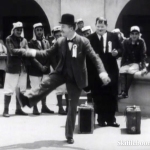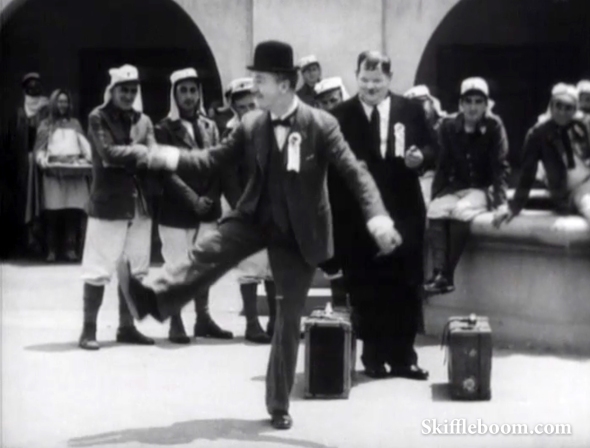Scene Breakdown: “The Seven Samurai” – Heihachi’s Funeral, from Michael McVey, Skiffleboom.com

Film as Art
Week 09 – Choosing Shots to Tell the Story, Assignment 9
By Michael McVey – April 22, 2010
Bunker Hill Community College – Charlestown, MA
Watch The Seven Samurai. Choose one scene and list each shot in it.
Identify what kind of camera angle was used (such as a wide shot, medium shot, close-up), any camera movements (dolly, pan, zoom, tilt), and a description of the action occurring in the scene (the movement of the actors, and so forth).
The Seven Samurai – Heihachi’s Funeral
The samurai bury Heihachi after he dies during a raid. The farmers and samurai mourn his loss. The wild Kikuchiyo galvanizes the village with Heihachi’s flag. At that moment, bandits attack that village.
Low-angle, Long shot of the hillside. Encircled by villagers, the samurai bow before Heihachi’s grave mound. The wind blows.
Low-angle, Medium long shot of samurai. This a zoomed shot at the same angle – the samurai perform the burial ritual.
Low-angle, Medium long shot of Kikuchiyo, framed left. This is an even closer view, same angle. The camera tracks Kikuchiyo as he plunges Heihachi’s sword into his grave, then sits, despondent.
Return to Low-angle, Long shot of the hillside. The samurai and farmers kneel before Heihachi’s grave mound.
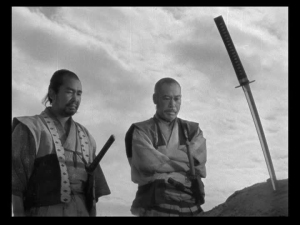 Medium, Low-angle shot of Kambei and Gorōbei, with Heihachi’s sword in the foreground. The two samurai speak of Heihachi and the hard times to come.
Medium, Low-angle shot of Kambei and Gorōbei, with Heihachi’s sword in the foreground. The two samurai speak of Heihachi and the hard times to come.
Medium, Low-angle shot of Rikichi and the farmers kneeling at the grave. As the farmers mourn, Rikichi breaks down and hugs the dirt, crying in despair. His actions accidently lead to Heihachi’s death. The camera pans left, following Rikichi as he snaps.
Return to Low-angle, Medium long shot of Kikuchiyo, framed left. Kikuchiyo yells at Rikichi to stop crying. The camera tilts as he stands.
Low-angle, Long shot of the hillside. Kikuchiyo yells at everyone to stop crying. He runs down the hillside.
Medium long shot, panning right to left, tracking Kikuchiyo. Kikuchiyo runs through the village.
 Long shot to Medium, tracking the movement of Kikuchiyo run through the village and into the samurai’s quarters. The camera pulls back as Kikuchiyo enters the building and pans left as he grabs Heihachi’s flag, then scrambles outside.
Long shot to Medium, tracking the movement of Kikuchiyo run through the village and into the samurai’s quarters. The camera pulls back as Kikuchiyo enters the building and pans left as he grabs Heihachi’s flag, then scrambles outside.
Long shot, low angle. The camera tilts up as Kikuchiyo climbs the thatched roof.
Wide shot with Samurai in the foreground, and Kikuchiyo on the roof in the distance. Kikuchiyo plants the flag in the thatched roof. The samurai see the flag and turn towards it.
Close-up on Heihachi’s flag. The flag stands tall, waving in the fierce wind.
Return to Low-angle, Long shot of the hillside. The farmers and samurai all turn to the flag.
Medium shot of farmers. The male farmers jockey for position, fixing eyes on the flag.
 Return to Close-up on Heihachi’s flag. The flag waves.
Return to Close-up on Heihachi’s flag. The flag waves.
Medium shot of farmers. The female farmers look on, teary eyed.
Extreme close-up of flag. The camera tilts down on the flag’s symbols.
 Medium close-up of farmers. Tears roll down the farmer’s cheeks. One farmer kneels in the foreground, the others stand in the background, mourning.
Medium close-up of farmers. Tears roll down the farmer’s cheeks. One farmer kneels in the foreground, the others stand in the background, mourning.
Return to Low-angle, Long shot of the hillside. The village stands together, staring at the flag.
Return to Extreme close-up of flag. Again, the camera tilts down on the flag’s symbols.
Medium shot of Kikuchiyo on the roof. Kikuchiyo sits, cradling himself under the flag. Something in the distance suddenly alarms him.
Wide shot of the distant hills. Bandits on horseback gallop over the horizon.
Return to Medium shot of Kikuchiyo on the roof. Kikuchiyo alertly stands and runs to the roof’s edge as the camera pans left, tracking him. He announces the bandit arrival to the village. “Goddamn! Here they come!”
A Scene from “Casablanca” – Rick Helps the Bulgarian Couple, from Michael McVey, Skiffleboom.com
Film as Art
Week 08 Logical Storytelling, Assignment 8
By Michael McVey – April 21, 2010
Bunker Hill Community College – Charlestown, MA
Watch Casablanca. Chose a scene and identify what the hero wants. Choose one scene from the movie and describe what it is about by using Mamet’s method of analysis in one short paragraph. (What does the hero do in this scene to try and get what he wants?)
Casablanca: Rick Helps the Young Couple
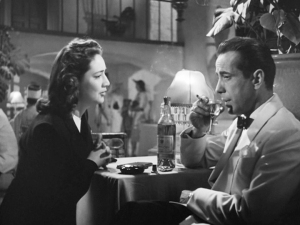 About an hour into Casablanca, Rick helps a young Bulgarian couple desperate to reach America. Rick’s objective in the scene is to quietly facilitate the young couple. He needs to keep his help secret, to maintain his reputation. Rick does not want to see the newly wed Bulgarian girl forced to trade sexual favors for an exit visa. Rick sympathizes with the couple’s predicament – he does not want them to experience the pain of a compromised relationship. There are a few steps Rick takes to accomplish his objective.
About an hour into Casablanca, Rick helps a young Bulgarian couple desperate to reach America. Rick’s objective in the scene is to quietly facilitate the young couple. He needs to keep his help secret, to maintain his reputation. Rick does not want to see the newly wed Bulgarian girl forced to trade sexual favors for an exit visa. Rick sympathizes with the couple’s predicament – he does not want them to experience the pain of a compromised relationship. There are a few steps Rick takes to accomplish his objective.
 Rick needs to secretly secure money for the couple’s exit visas. Rick enters the room and makes contact with the roulette dealer – a dealer who works for Rick. Rick straddles up to the young Bulgarian man. He advises the man to bet on 22. Rick needs to communicate with the dealer to fix the game. Rick repeats himself so that the dealer hears. The dealer correctly interprets Rick’s tone and look: roll a 22. The dealer rolls 22, and the man collects. Again, Rick advises the man to bet on 22. The dealer understands Rick’s unspoken orders. The man bets and wins. Rick succeeds in getting the Bulgarian couple enough money to exit Casablanca.
Rick needs to secretly secure money for the couple’s exit visas. Rick enters the room and makes contact with the roulette dealer – a dealer who works for Rick. Rick straddles up to the young Bulgarian man. He advises the man to bet on 22. Rick needs to communicate with the dealer to fix the game. Rick repeats himself so that the dealer hears. The dealer correctly interprets Rick’s tone and look: roll a 22. The dealer rolls 22, and the man collects. Again, Rick advises the man to bet on 22. The dealer understands Rick’s unspoken orders. The man bets and wins. Rick succeeds in getting the Bulgarian couple enough money to exit Casablanca.
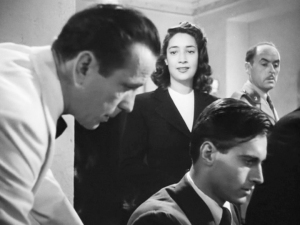 Rick’s second objective is to keep the whole affair quiet. Rick tells the man to cash out his chips and leave permanently. The man complies. Rick asks the dealer how they are doing? The dealer replies that they are down a couple thousand, and he winks knowingly. Since the other witnesses and participants work for Rick, the transaction remains secret. The Bulgarian woman approaches Rick and hugs him gratefully. This jeopardizes Rick’s objective of keeping his sentimental actions quiet. Rick coolly ends the hug and tells the woman her husband is “just a lucky guy.” He downplays the potentially emotional scene, keeping the whole affair quiet. Reputation intact, Rick succeeds in both helping the couple and maintaining secrecy. This scene is very efficient in handling Rick’s objectives. His goals are clear without being obvious. Rick’s true character is revealed, and the scene becomes more emotional by having characters conceal their emotions.
Rick’s second objective is to keep the whole affair quiet. Rick tells the man to cash out his chips and leave permanently. The man complies. Rick asks the dealer how they are doing? The dealer replies that they are down a couple thousand, and he winks knowingly. Since the other witnesses and participants work for Rick, the transaction remains secret. The Bulgarian woman approaches Rick and hugs him gratefully. This jeopardizes Rick’s objective of keeping his sentimental actions quiet. Rick coolly ends the hug and tells the woman her husband is “just a lucky guy.” He downplays the potentially emotional scene, keeping the whole affair quiet. Reputation intact, Rick succeeds in both helping the couple and maintaining secrecy. This scene is very efficient in handling Rick’s objectives. His goals are clear without being obvious. Rick’s true character is revealed, and the scene becomes more emotional by having characters conceal their emotions.
A Scene from Danny Boyle’s “Sunshine” – Kaneda’s Decision, from Michael McVey, Skiffleboom.com
Film as Art
Week 07 – Planning the Mise-en-Scene, Assignment 7
Michael McVey
Bunker Hill Community College – April 8, 2010
Watch Sunshine. Choose one scene from the movie and describe the entire mise-en-scene (everything that you can see and hear, including the actors’ movements, costumes, lighting, sound, set, camera angle, and shot-size).
Sunshine
Scene – Full Sunlight, Kaneda’s Decision
 A powerful, low tone sounds as we open on an extremely wide aerial shot of Icarus II’s heat shield. The camera sweeps over the vast field of metallic panels. Yellow, orange, and red fires glimmer on the distant horizon. The looming sunlight slices through the darkness, racing towards our characters, Kaneda and Capa. The electronic crackle and shimmer of the heat interweave with the film’s score. An ethereal chorus sustains an ominous, almost mystical chord.
A powerful, low tone sounds as we open on an extremely wide aerial shot of Icarus II’s heat shield. The camera sweeps over the vast field of metallic panels. Yellow, orange, and red fires glimmer on the distant horizon. The looming sunlight slices through the darkness, racing towards our characters, Kaneda and Capa. The electronic crackle and shimmer of the heat interweave with the film’s score. An ethereal chorus sustains an ominous, almost mystical chord.
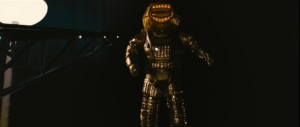 We cut to Kaneda, Captain of the Icarus II. As he stands in his unwieldy, gold-plated space suit, the camera dollies in from a low medium shot to a close-up. A critical heat shield panel closes slowly on frame left. We see the reflective glow of the approaching sunlight glisten across his helmet. Behind him, there is nothing but the cold, empty void of space. The feminine, computerized voice of Icarus updates the ship’s status: “89% of shield in full sunlight.”
We cut to Kaneda, Captain of the Icarus II. As he stands in his unwieldy, gold-plated space suit, the camera dollies in from a low medium shot to a close-up. A critical heat shield panel closes slowly on frame left. We see the reflective glow of the approaching sunlight glisten across his helmet. Behind him, there is nothing but the cold, empty void of space. The feminine, computerized voice of Icarus updates the ship’s status: “89% of shield in full sunlight.”
 We cut to an extreme close-up of Kaneda’s eyes, the interior of this helmet. His eyes absorb the approaching sunlight. The fiery horizon is reflected across the screen, refracted through his helmet’s small slot. The sunlight intensifies before him, from soft orange to a severe yellow. Kaneda’s eyes widen, his breath quickens. The electronic score sounds like a submarine buckling under the pressure; low-frequency droning underlies the soundtrack.
We cut to an extreme close-up of Kaneda’s eyes, the interior of this helmet. His eyes absorb the approaching sunlight. The fiery horizon is reflected across the screen, refracted through his helmet’s small slot. The sunlight intensifies before him, from soft orange to a severe yellow. Kaneda’s eyes widen, his breath quickens. The electronic score sounds like a submarine buckling under the pressure; low-frequency droning underlies the soundtrack.
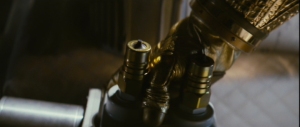 We cut to an extreme close-up of Capa’s gloved hand. He too dons a gold-lined protective suit. We track Capa’s hand as he installs a mechanical device inside a broken heat panel. The low-frequency soundtrack continues.
We cut to an extreme close-up of Capa’s gloved hand. He too dons a gold-lined protective suit. We track Capa’s hand as he installs a mechanical device inside a broken heat panel. The low-frequency soundtrack continues.
 We cut to an extreme close-up of the dark interior of Capa’s helmet. His face is strained and sweating on the left of the screen. On the right are small electronic displays – one of Kaneda’s helmet interior and the one of the Icarus’ bridge. We are able to see through the helmet slot to the exterior, where Capa installs the component. Capa breathes heavily. Subtle electronic beeps and whirs complement the droning soundtrack.
We cut to an extreme close-up of the dark interior of Capa’s helmet. His face is strained and sweating on the left of the screen. On the right are small electronic displays – one of Kaneda’s helmet interior and the one of the Icarus’ bridge. We are able to see through the helmet slot to the exterior, where Capa installs the component. Capa breathes heavily. Subtle electronic beeps and whirs complement the droning soundtrack.
 We cut to a low, wide shot of the dark exterior. Kaneda is maneuvers in the zero-G over to Capa from screen right to left, and we pan slightly to follow. As Capa toils, the sunlight’s orange aura silhouettes the open heat panel. A work lamp floats in the mid-ground. Kaneda’s static radio communication to Capa punctuates the intense score: “Capa, go back. I can finish this.”
We cut to a low, wide shot of the dark exterior. Kaneda is maneuvers in the zero-G over to Capa from screen right to left, and we pan slightly to follow. As Capa toils, the sunlight’s orange aura silhouettes the open heat panel. A work lamp floats in the mid-ground. Kaneda’s static radio communication to Capa punctuates the intense score: “Capa, go back. I can finish this.”
 We cut back to the previous interior close-up of Capa’s helmet. Capa responds to Kaneda, and we hear his unfiltered voice echo within the cramped helmet: “Please, I can do this.”
We cut back to the previous interior close-up of Capa’s helmet. Capa responds to Kaneda, and we hear his unfiltered voice echo within the cramped helmet: “Please, I can do this.”
 We cut to the interior of Kaneda’s helmet. The shot is a close-up, a mirror shot of Capa’s helmet interior. Kaneda’s face holds the right of the frame. Through his helmet slot, the burning yellow glow strengthens. The in-helmet displays flicker ominously with static as Kaneda broadcasts his final order: “Go.”
We cut to the interior of Kaneda’s helmet. The shot is a close-up, a mirror shot of Capa’s helmet interior. Kaneda’s face holds the right of the frame. Through his helmet slot, the burning yellow glow strengthens. The in-helmet displays flicker ominously with static as Kaneda broadcasts his final order: “Go.”
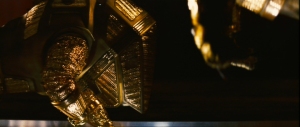 We cut to an exterior medium shot. At this moment, John Murphy’s score cues a swelling adagio. Capa and Kaneda slowly pass each other in zero-G, their bulky-suited bodies parallel with the heat shield’s surface. As they pass each other, the soundtrack drops out and lets the score emotionally supplement the fateful decision.
We cut to an exterior medium shot. At this moment, John Murphy’s score cues a swelling adagio. Capa and Kaneda slowly pass each other in zero-G, their bulky-suited bodies parallel with the heat shield’s surface. As they pass each other, the soundtrack drops out and lets the score emotionally supplement the fateful decision.
 We cut back to the previous interior close-up of Capa’s helmet. “Capa returning to airlock. Do you copy?”
We cut back to the previous interior close-up of Capa’s helmet. “Capa returning to airlock. Do you copy?”
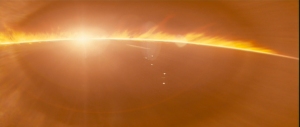 We cut to a grand, sweeping aerial wide shot of the set piece. It is a stark contrast to the dark interior of Capa’s helmet. The frame is filled with the overwhelming orange and yellow glow of the sunlight. Lens flares add to the FX shot’s effectiveness and realism. The sunlight dances like a fire in the distance. The shimmering sounds of an electronic inferno rise as we push past Capa and Kaneda, who are dwarfed by the scale of Icarus’ heat shield. While Capa has covered some distance to the shield’s edge, it is insignificant compared to the distance left to travel. Unheeded by Icarus, Capa restates his question: “Capa returning to airlock. Do you copy?” The camera rotates as it flies by, keeping Capa and Kaneda center frame. As our angle changes, the background becomes the icy emptiness of space, and the sounds of the fire fade. The voice of the ship’s pilot Cassie responds: “Copy, Capa. Hurry.” The shot illustrates the enormous distances between the men, the shield’s edge, and the devastating heat approaching them. The score swells as the camera pulls back, the two men barely visible. The camera begins to shake violently, as we break into the red sunlight’s threshold. The voice of Icarus updates: “91% of shield in full sunlight.”
We cut to a grand, sweeping aerial wide shot of the set piece. It is a stark contrast to the dark interior of Capa’s helmet. The frame is filled with the overwhelming orange and yellow glow of the sunlight. Lens flares add to the FX shot’s effectiveness and realism. The sunlight dances like a fire in the distance. The shimmering sounds of an electronic inferno rise as we push past Capa and Kaneda, who are dwarfed by the scale of Icarus’ heat shield. While Capa has covered some distance to the shield’s edge, it is insignificant compared to the distance left to travel. Unheeded by Icarus, Capa restates his question: “Capa returning to airlock. Do you copy?” The camera rotates as it flies by, keeping Capa and Kaneda center frame. As our angle changes, the background becomes the icy emptiness of space, and the sounds of the fire fade. The voice of the ship’s pilot Cassie responds: “Copy, Capa. Hurry.” The shot illustrates the enormous distances between the men, the shield’s edge, and the devastating heat approaching them. The score swells as the camera pulls back, the two men barely visible. The camera begins to shake violently, as we break into the red sunlight’s threshold. The voice of Icarus updates: “91% of shield in full sunlight.”

